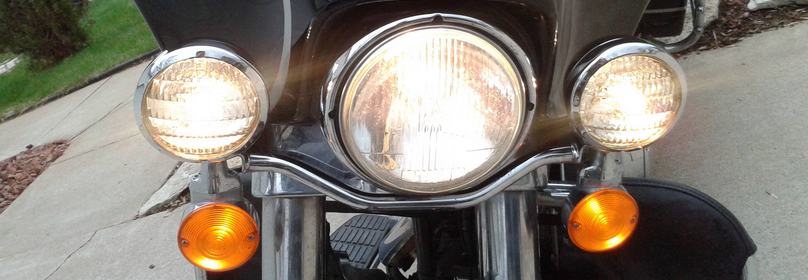Tractor Lights and Upgradability
See those smaller white lights on the sides of this motorcycle headlight? Those are called fog lights. Harley Davidson calls them passing lights.
This is the front of a 2003 Harley Ultra. When I bought the thing I was under the presumption that there would be parts, forever, for any Harley model. The scale of Harley parts is massive — for instance, if you order catalogs from Dennis Kirk in Minnesota or J&P Cycles in Anamosa IA you have to specify HARLEY or THE REST. The catalogs are massive, and the H-D catalogs for parts are as big as or larger than the catalogs for all other brands *combined*.
A sad day came a few weeks ago when I took my bike in and got maintenance done, and the one of my fog lights was burned out. Harley service came back and said “$70 to fix one.” What, for a bulb? This was more than the usual exclusivity fee.
Well it turns out almost none of the dealers carries bulbs for 11 year old bikes anymore and they were going to upgrade me to something modern, and I am guessing, out of context with the timeless form so few manufacturers have achieved: Harley for one, and Ducati for another (IMHO of course).
But . . . no freakin’ lamps, a common maintenance item, for this bike? That’s nuts. I told them no, I’ll get my own — they were cool with it (and I suspect sympathized).
I trotted over to the local Farm and Fleet and there I found Phillips 4411 bulbs with the slip-on connectors I needed for $8 a piece. They came up on the cashier screen as “tractor lights.” Made sense — in the old days a lot of Harley dealerships shared space with John Deere, Case, and International Harvester equipment.
 Finding standard parts for anything is a concern. Once I talked with a guy who had toured South America on a bicycle — he said a person would be nuts to use a 700c wheel (commonest road bike size) because all’s they have down there are 26″ wheel parts — tubes, spokes, tires. On the flip I remember owning a few Chevy pickups and the Haynes manual covered 1967-1984 — almost 20 years of interchangeable parts save some Navajo body decals or an 8-track player. Imagine . . . .
Finding standard parts for anything is a concern. Once I talked with a guy who had toured South America on a bicycle — he said a person would be nuts to use a 700c wheel (commonest road bike size) because all’s they have down there are 26″ wheel parts — tubes, spokes, tires. On the flip I remember owning a few Chevy pickups and the Haynes manual covered 1967-1984 — almost 20 years of interchangeable parts save some Navajo body decals or an 8-track player. Imagine . . . .
There are tie-ins to this idea in software. For instance, when picking out a technology for a new application — like maybe UX frameworks — don’t we look at the one with the most options, support, and probably longevity?
And recently I have been researching big data engines. Been playing around with Apache Tez and Cassandra and thinking, hmmmm, I’m going to analyze log files with this should I get good at it — maybe tie it into my web site data miner I wrote in Groovy. Dunno.
A big data engine evaluatory article I came across had this observation in the comments discussion how RavenDB failed to scale for them:
Speaking of RavenDB 2.0, you guys did a lot of funky stuff on the Raven Client that forced us to rewrite major portions of our app – limiting the number of async calls made in a single session to 1 was the issue, IIRC. I ended up scrapping the project and had us roll back to RavenDB 1.0 until we migrated off of it since there were just too many things we had to change at once in order for our app to support RavenDB 2.0.
So imagine that you put all this time into something and hit the feature wall.
My observations about this are:
- You can only pick a technology as well as you can that day.
- Nothing will prepare you for the type of obsolescence you will run into in the future.
- Making things work might be cheap. Maybe $8, if you get lucky. But in my experience they get expensive.
For instance, an organization I did some FileMaker Pro work on waited too long to upgrade their database. All their forms, everything, done for. Was time to sunset that application . . . or limp along knowing that death was near.
On the other hand you might get lucky. XP just got sunsetted — after what, 13 years? That’s a long life for any OS.
Software isn’t really a Harley; its not even a cultural artifact its just some code that does something for now. Harleys have been around because the designers hit the form and functionality sweet spot right on. Even if I can’t get those 4411’s I can still get something newer for my ’03. Cobol did that, the C languages and Java. Bleeding edge might return ROI — or it might end up like the Excelsior-Henderson Super X — flashy, awesome and just not around anymore. Maybe a little of both is best.
